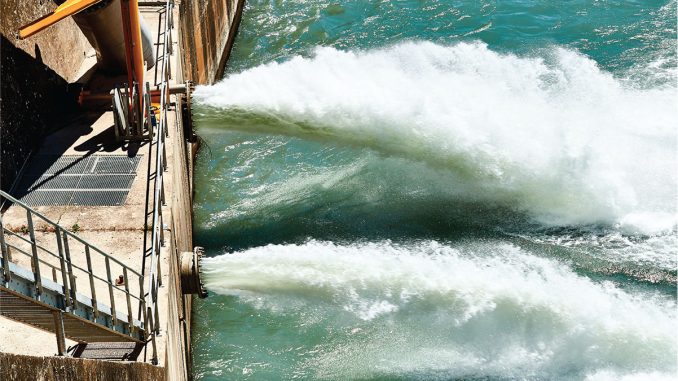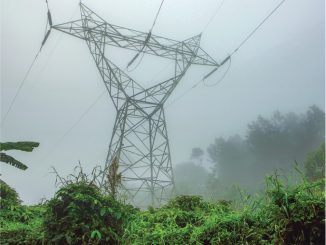
Hydroelectric plants (HEPs) have matured as a technology and they now have the ability to rapidly ramp up or down generation in order to adjust according to load, meet peak demand requirements, and compensate for intermittent generation from renewable energy sources whenever needed. This traditional form of clean energy offers a number of technical and economic benefits. In terms of generation costs, it is considered more cost effective than fossil fuel-based power plants. These plants help reduce financial losses due to frequency fluctuations. Due to their unique capability of quick starting and closing, HEPs are an economical choice to meet peak load in the grid.
There is also an emphasis on increasing hydropower pumped storage plants (PSPs), as they are a viable solution to the intermittency issues of renewable energy sources in the long term. Pumped storage hydropower works by pumping water from a lower reservoir to an upper reservoir, and then releasing the stored water from the upper reservoir to generate power via turbines when there is a demand for energy.
Although hydropower is one of the oldest forms of renewable energy, its growth has been quite slow in the country. As of October 2022, India has an installed HEP capacity of 46,850 MW. The sector faces several challenges such as financial constraints on project approval, problems related to land acquisition, societal resistance by local populations, and geological and environmental concerns.
Over the past year, there have been multiple developments in the hydropower space. Several ventures have been initiated to promote projects and pumped energy storage facilities via national and international alliances. Renewable Watch provides a roundup of the key developments in this space over the past year…
November 2022: Serentica Renewables entered into an agreement with the Greenko Group for 1.5 GWh of energy storage capacity as part of its plans to provide round-the-clock supply of renewable energy to its various industrial clients.
October 2022: JSW Energy Limited signed an MoU with the Maharashtra government to build a 960 MW hydro PSP. This collaboration will secure resources amounting to around 6 GW of hydro PSPs from the governments of various states, including Maharashtra, Chhattisgarh, Telangana, and Rajasthan. JSW Neo Energy Limited also received a letter of intent from the Himachal Pradesh government for developing the 126 MW Chhatru HEP.
September 2022: ANDRITZ received an order from Greenko MP01 IREP Private Limited, for electromechanical works at the Gandhi Sagar PSP. The project has a capacity of 1,440 MW and will be located in Kheemla block village in Neemuch district of Madhya Pradesh.
August 2022: SJVN Limited announced an agreement with Kalpataru Power Transmission Limited to build a 220 kV direct current single zebra transmission line for the 210 MW Luhri HEP Stage 1. The project intends to produce 758 MUs of energy per year.
July 2022: NHPC Limited and the Damodar Valley Corporation agreed to create a joint venture company to explore and develop hydropower and PSPs. Further, the 180 MW Bajoli Holi project was commissioned by GE Renewable Energy’s hydropower business, which is a part of GE Power India Limited. Since the project was connected to the grid in March 2022, three units of 60 MW each have been generating electricity.
June 2022: The chief minister of Andhra Pradesh approved PSPs proposed by Adani Green Energy with a total capacity of 3,700 MW. Tamil Nadu Generation and Distribution Company Limited (Tangedco) planned to conduct a feasibility study on three hydropower projects that will generate 2,500 MW of power. Tangedco asked a private consultant to conduct a study and prepare an initial report for establishing pumped storage hydropower stations of 1,000 MW capacity each in Upper Bhavani and Sandy Nalla.
April 2022: The JSW Group announced plans to develop a 900 MW pumped storage hydel power project in West Bengal. The West Bengal government agreed to construct a third PSP plant at the Bandhunala project in Purulia. Further, JSW Neo Energy Limited signed an MoU with the Chhattisgarh government for setting up a 1,000 MW hydro PSP at Hasdev Bango. The Odisha government sought viability gap funding for promotion of hydropower PSP. The state intends to set up plants in Upper Indravati (600 MW), Balimela (500 MW) and Upper Kolab (320 MW).
March 2022: The Adani Group and the Greenko Group partnered to utilise standalone long-duration hydro energy storage capacity in order to provide round-the-clock power to the Adani Group’s facilities in India.
December 2021: The prime minister inaugurated and laid the foundation stones of several HEPs worth over Rs 110 billion in Himachal Pradesh. These included the Renukaji Dam project, the Luhri Stage 1 HEP and the Dhaulasidh HEP. He also inaugurated the Sawra-Kuddu HEP.
November 2021: International technology group ANDRITZ received an order from the state government-owned utility Assam Power Generation Corporation Limited for supply of all electromechanical equipment for the Lower Kopili HEP, located on the Kopili river in central Assam.
Policy impetus
Smart policies and strategies are actively being taken up by the Government of India for uplifting the HEP sector. In September 2022, the Ministry of Power (MoP) amended the scheme for Flexibility in Generation and Scheduling of Thermal/ Hydro Power Stations through bundling with Renewable Energy and Storage Power. Further, in August 2022, the guidelines for the tariff-based competitive bidding process for procurement of power from grid-connected renewable energy power projects for utilisation under the aforementioned scheme were revised. The objectives of these guidelines were to ensure standardisation and uniformity in processes and create a framework for risk sharing among various stakeholders involved in renewable power procurement. The policy changes are expected to encourage investments, enhance the bankability of projects and the profitability for investors.
In July 2019, the Dam Safety Bill was introduced. It was passed by the Rajya Sabha in December 2021, and become the Dam Safety Act, 2021. The act was made necessary by the poor infrastructure and maintenance of the ageing dams. The act mandates adequate surveillance, inspection, and O&M of all large dams across the country to prevent dam failure-related disasters. Furthermore, the act establishes an institutional mechanism at both the central and state levels to address the structural and non-structural measures required for dam safety.
The government has also notified the hydropower purchase obligation (HPO) trajectory, which has given states hydropower procurement targets. The HPO notice applies to all obligated entities and covers all large hydro projects completed on or after March 2019. This will further help the sector meet the target of 30,000 MW of hydro capacity addition by 2030. The HPO mechanism has been welcomed by the industry, as it will ensure greater offtake from hydropower projects.
Outlook
The active policy measures being implemented by the government and the HPO notification have affirmed that policymakers look at hydropower as an important source of power for the grid. Thus, the upcoming technologies and innovations in this space are highly important. There may be a substantial opportunity to utilise the co-benefits of hybridising existing and planned hydropower with floating solar photovoltaic (FPV) systems. When combined with reservoir-based hydropower, hybrid FPV hydropower systems can help lower capital costs. This is because they offer the benefits of deploying existing grid connections, reduced solar PV curtailment, improved system operation at different time scales, additional energy storage opportunities, improved transmission usage and water resource conservation. To this end, in August 2021, Bangladesh scientists evaluated the integration of a 50 MW floating PV plant with the 230 MW Karnafuli HEP located at the Kaptai Dam on the Karnaphuli river.
Also, with the growing uptake of green hydrogen projects, existing hydropower producers can play a critical role in the transition to a hydrogen economy. As green hydrogen technology advances and costs fall, hydropower-hydrogen hybrid systems may become an important accelerator of the clean energy transition.
Going forward, effective O&M procedures and the usage of modern technology can help in utilising the capacity of existing HEPs. PSPs are expected to grow as the deployment of renewable energy increases.



